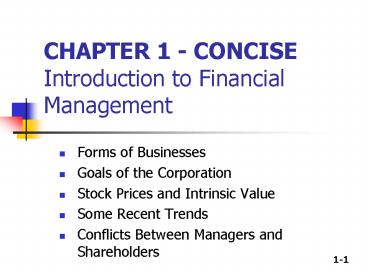CHAPTER 1 CONCISE Introduction to Financial Management - PowerPoint PPT Presentation
1 / 17
Title:
CHAPTER 1 CONCISE Introduction to Financial Management
Description:
Alternative Forms of Business Organization. Proprietorship. Partnership. Corporation ... Alternative Forms of Business Organization ... The globalization of business ... – PowerPoint PPT presentation
Number of Views:97
Avg rating:3.0/5.0
Title: CHAPTER 1 CONCISE Introduction to Financial Management
1
CHAPTER 1 - CONCISEIntroduction to Financial
Management
- Forms of Businesses
- Goals of the Corporation
- Stock Prices and Intrinsic Value
- Some Recent Trends
- Conflicts Between Managers and Shareholders
2
Alternative Forms of Business Organization
- Proprietorship
- Partnership
- Corporation
3
Proprietorships Partnerships
- Advantages
- Ease of formation
- Subject to few regulations
- No corporate income taxes
- Disadvantages
- Difficult to raise capital
- Unlimited liability
- Limited life
4
Corporation
- Advantages
- Unlimited life
- Easy transfer of ownership
- Limited liability
- Ease of raising capital
- Disadvantages
- Double taxation
- Cost of set-up and report filing
5
- Double Taxation of Corporate Profits/Income
- Assume Corporate and Individual Tax 50
- Earnings Before Taxes 100 EBT
- (50) Corporate Tax
- Net Income After Tax 50 NIAT (Profits)
- Assume 100 Div. Payout 50 Dividend Income
- (25) Personal Income Tax
- 25 After-tax Income
- New Tax Code (2003) Max. Tax Rate of 15 for
DIV - Earnings Before Taxes 100 EBT
- (50) Corporate Tax
- Net Income After Tax 50 NIAT
- Assume 100 DIV 50 Dividend Income
- (7.50) Income Tax _at_ 15
- 42.50 After-tax Income
6
- Corporate Income Taxes 2006
- More than But not more than Then the tax
is of the amount over - 0 50,000 15 0
- 50,000 75,000 7,500 25 50,000
- 75,000 100,000 13,750 34 75,000
- 100,000 335,000 22,250 39 100,000
- 335,000 10 million 113,900 34 335,000
- 10 million 15 million 3,4 million 35 10
million - 15 million 18.33 million 5.15 million
38 15 million - 18.33 million --35 --
7
- 2005 federal personal income tax ratesOrdinary
taxable income for use in filing returns due
April 15, 2006. - Tax rate Single filers Married filing jointly
Married filing separately Head of household - 10 Up to 7,300 Up to 14,600 Up to 7,300
Up to 10,450 - 15 7,301 - 29,700 14,601 - 59,400 7,301
- 29,700 10,451 - 39,800 - 25 29,701 - 71,950 59,401 - 119,950
29,701 - 59,975 39,801-102,800 - 28 71,951 - 150,150 119,951 - 182,800
59,976 - 91,400 102,801 - 166,450 - 33 150,151 - 326,450 182,801 - 326,450
91,401 - 163,225 166,451 - 326,450 - 35 326,451 or more 326,451 or more 163,226
or more 326,451 or more
8
Alternative Forms of Business Organization
- Sole proprietorship 73 of firms, but only 7
of sales revenue - Partnership 7 of firms, 5 of sales
- Corporation 20 of firms, but 88 of sales
revenue.
9
Financial Goals of the Corporation
- The primary financial goal is shareholder wealth
maximization, which translates to maximizing
stock price. - Do firms have any responsibilities to society at
large? - Is stock price maximization good or bad for
society? - Should firms behave ethically?
10
Factors that affect stock price
- Projected cash flows to shareholders
- Timing of the cash flow stream
- Riskiness of the cash flows
11
Stock Prices and Intrinsic Value
- In equilibrium, a stocks price should equal its
true or intrinsic value. - To the extent that investor perceptions are
incorrect, a stocks price in the short run may
deviate from its intrinsic value. - Ideally, managers should avoid actions that
reduce intrinsic value, even if those decisions
increase the stock price in the short run.
12
Determinants of Intrinsic Value and Stock Prices
(Figure 1-1)
13
Some Important Trends
- Recent corporate scandals have reinforced the
importance of business ethics, and have spurred
additional regulations and corporate oversight. - The effects of changing information technology
have had a profound effect on all aspects of
business finance. - The continued globalization of business.
14
Financial Management Issues of the New Millennium
- The effect of changing technology
- The globalization of business
- 1. Improvements in communications and
transportation lower transactions cost - 2. Increased power of consumers more choice,
consumer sovereignty - 3. Increased cost of developing new products
global markets spread fixed costs over more units - 4. MNCs must be able to shift production
globally to take advantage of cost efficiencies.
15
Percentage of Revenue and Net Income from
Overseas Operations for 10 Well-Known
Corporations, 2001
16
Conflicts Between Managers and Stockholders
- Managers are naturally inclined to act in their
own best interests (which are not always the same
as the interest of stockholders). - But the following factors affect managerial
behavior - Managerial compensation plans
- Direct intervention by shareholders
- The threat of firing
- The threat of takeover
17
Responsibility of the Financial Staff
- Maximize stock value by
- Forecasting and planning
- Investment and financing decisions
- Coordination and control
- Transactions in the financial markets
- Managing risk































